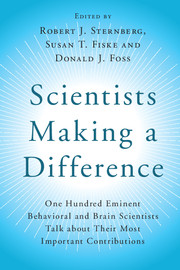 Scientists Making a Difference
Scientists Making a Difference Book contents
- Frontmatter
- Contents
- List of Contributors
- Foreword: Making a Creative Difference = Person × Environment
- Preface
- Part I Introduction
- Part II Biological Bases of Psychology: Genes, Brain, and Beyond
- Section A Feelings, Fears, Stressors, and Coping
- 2 Feelings and Decisions
- 3 My Career in Fear
- 4 Child Poverty and Brain Development
- 5 Try It and Assume Nothing
- 6 Coming Full Circle: From Psychology to Neuroscience and Back
- 7 Hormones, Epigenetics, the Brain, and Behavior
- 8 Brain Plasticity, Science, and Medicine
- Section B Cognitive and Social Neuroscience
- Section C Behavioral and Molecular Genetics
- Part III Cognition: Getting Information from the World and Dealing with It
- Part IV Development: How We Change Over Time
- Part V Motivation and Emotion: How We Feel and What We Do
- Part VI Social and Personality Processes: Who We Are and How We Interact
- Part VII Clinical and Health Psychology: Making Lives Better
- Part VIII Conclusion
- Afterword: Doing Psychology 24×7 and Why It Matters
- Index
- References
8 - Brain Plasticity, Science, and Medicine
from Section A - Feelings, Fears, Stressors, and Coping
Published online by Cambridge University Press: 05 August 2016
- Frontmatter
- Contents
- List of Contributors
- Foreword: Making a Creative Difference = Person × Environment
- Preface
- Part I Introduction
- Part II Biological Bases of Psychology: Genes, Brain, and Beyond
- Section A Feelings, Fears, Stressors, and Coping
- 2 Feelings and Decisions
- 3 My Career in Fear
- 4 Child Poverty and Brain Development
- 5 Try It and Assume Nothing
- 6 Coming Full Circle: From Psychology to Neuroscience and Back
- 7 Hormones, Epigenetics, the Brain, and Behavior
- 8 Brain Plasticity, Science, and Medicine
- Section B Cognitive and Social Neuroscience
- Section C Behavioral and Molecular Genetics
- Part III Cognition: Getting Information from the World and Dealing with It
- Part IV Development: How We Change Over Time
- Part V Motivation and Emotion: How We Feel and What We Do
- Part VI Social and Personality Processes: Who We Are and How We Interact
- Part VII Clinical and Health Psychology: Making Lives Better
- Part VIII Conclusion
- Afterword: Doing Psychology 24×7 and Why It Matters
- Index
- References
Summary
My motivation for pursuing studies in integrative neuroscience stemmed from a juvenile interest in the “great issues” of philosophy and psychology. As a student, it seemed obvious to me that the “rules” that underlie our psychology are discoverable brain rules, and that the disputes of historic philosophy would be trumped by neurological science. Alas, in the early period of my own studies, scientists had not gotten very far in addressing these great issues of philosophy and psychology in direct neurological terms. A dramatic change was to occur over the subsequent five decades of my scientific life.
Our own contributions to a progressive change in an understanding of our humanity initially stemmed from two principal sources. First, I led a team that created one of the first commercialized multiple-channel cochlear implants. These hearing recovery devices deliver patterned electrical stimuli to the auditory nerve in deaf individuals, thereby restoring aural speech understanding. Our ability to simulate the highly detailed representation of aural speech inputs normally delivered from the ear to the brain was, to say the least, crude. I've described it as akin to playing a Chopin sonata with your forearms. Not surprisingly, this new and radically degraded representational form of encoded speech was initially incomprehensible.
Several months later, our patients understood everything.
In the same era, research teams in Melbourne and Vienna created other multichannel cochlear implant models, applying very different speech encoding schemes. To our great surprise, several months later, even with their very different “front end” encoding, their patients also understood everything. The brain just didn't care. Moreover, both our patients and their patients said that their recovered speech sounded “just like it did before [they had lost their hearing].”
We realized that, especially given these three very different forms of artificial speech coding, a remarkable level of adaptive brain change – plasticity – must be contributing to the recovery of their speech understanding and the seamless cognitive extensions in the uses of aural language observed in cochlear implant patients. Contrary to the predominant neuroscientific view in this era, the adult human brain must be continuously plastic, on a grand scale.
- Type
- Chapter
- Information
- Scientists Making a DifferenceOne Hundred Eminent Behavioral and Brain Scientists Talk about Their Most Important Contributions, pp. 37 - 42Publisher: Cambridge University PressPrint publication year: 2016
